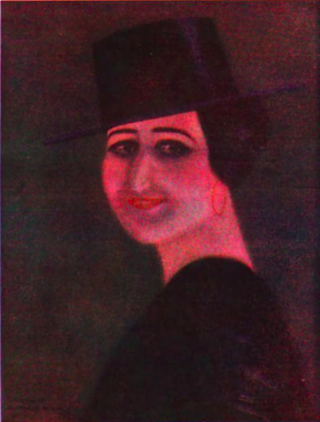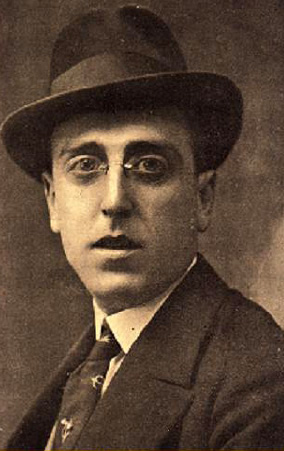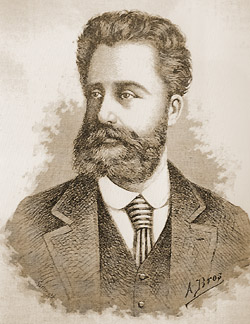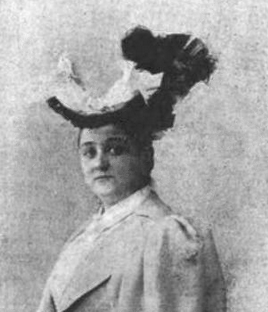
Zarzuela is a Spanish lyric-dramatic genre that alternates between spoken and sung scenes, the latter incorporating operatic and popular songs, as well as dance. The etymology of the name is uncertain, but some propose it may derive from the name of a royal hunting lodge, the Palace of Zarzuela, near Madrid, where that type of entertainment was allegedly first presented to the court. The palace in turn was named after the brambles that grew there.
Género chico is a Spanish genre of short, light plays with music. It is a major branch of zarzuela, Spain's form of popular music theatre with dialogue, and differs from zarzuela grande and most other operatic forms both in its brevity and by being aimed at audiences of a wide social spectrum.

Ataúlfo Exuperio Martín de Argenta Maza was a Spanish conductor and pianist.

Rita Aurelia Fulcida Montaner y Facenda, known as Rita Montaner, was a Cuban singer, pianist and actress. In Cuban parlance, she was a vedette, and was well known in Mexico City, Paris, Miami and New York, where she performed, filmed and recorded on numerous occasions. She was one of Cuba's most popular artists between the late 1920s and 1950s, renowned as Rita de Cuba. Though classically trained as a soprano for zarzuelas, her mark was made as a singer of Afro-Cuban salon songs including "The Peanut Vendor" and "Siboney".
Cuban musical theatre has its own distinctive style and history. From the 18th century to modern times, popular theatrical performances included music and often dance as well. Many composers and musicians had their careers launched in the theatres, and many compositions got their first airing on the stage. In addition to staging some European operas and operettas, Cuban composers gradually developed ideas which better suited their creole audience. Characters on stages began to include elements from Cuban life, and the music began to reflect a fusion between African and European contributions.

Jesús Guridi Bidaola was a Spanish Basque composer who was a key player in 20th-century Spanish and Basque music. His style fits into the late Romantic idiom, directly inherited from Wagner, and with a strong influence from Basque culture. Among his best-known works are the zarzuela El Caserío, the opera Amaya, the orchestral work Ten Basque Melodies and his organ works, where the Triptych of the Good Shepherd can be highlighted.
Rodrigo Prats was a Cuban composer, arranger, violinist, pianist and orchestral director.

Moisés Simons, was a leading Cuban composer, pianist, and orchestra leader. He was the composer of El Manisero which is considered by many to be the most famous piece of music created by a Cuban musician and has since been recorded by other musicians from around the world hundreds of times.

Tonadilla was a Spanish musical song form of theatrical origin; not danced. The genre was a type of short, satirical musical comedy popular in 18th-century Spain, and later in Cuba and other Spanish colonial countries.
Alvia is a high-speed train service in Spain offered by Renfe Operadora on long-distance routes with a top speed of 250 km/h (160 mph). The trains have the ability to use both Iberian gauge and standard gauge, which allows them to travel on the recently constructed high-speed lines for part of the journey before switching to the "classic" Iberian gauge network to complete it. Trains that run exclusively on high-speed tracks are branded AVE or Avant.

Guillermo Fernández-Shaw Iturralde was a Spanish poet and journalist. He is particularly known as a writer of libretti, primarily for zarzuelas. With Federico Romero, he wrote the libretti for two of the best-known zarzuelas of the 20th century, Doña Francisquita by Amadeo Vives and Luisa Fernanda by Federico Moreno Torroba. His father, Carlos Fernández Shaw, was also a playwright, poet and journalist who wrote libretti for several zarzuelas and operas, most famously Margarita la tornera and La vida breve. Guillermo Fernández-Shaw was born in Cádiz and initially trained as a lawyer before becoming a journalist. He was the editor of the Spanish newspaper La Epoca from 1911 to 1936, and a contributor to ABC as well as writing poetry for Blanco y Negro. His partnership with Federico Romero began in 1916 with their libretto for Serrano's La canción del olvido. Guillermo Fernández-Shaw died in Madrid on 17 August 1965 at the age of 72.

Federico Romero Saráchaga was a Spanish poet and essayist. He is particularly known as a writer of libretti, primarily for zarzuelas. Although he was born in Oviedo and lived at times in both Zaragoza and Madrid, he considered himself a son of Spain's La Mancha region, where his family had lived from the early 20th century in the small town of La Solana. The zarzuela La rosa del azafrán, composed by Jacinto Guerrero to a libretto by Romero, is considered emblematic of the region.
Joaquín Valverde Durán was a Spanish composer, conductor and flautist. As a composer he is known for his collaborations on zarzuelas. He was also the father of Joaquín "Quinito" Valverde Sanjuán, who achieved a greater level of fame.
Joaquín "Quinito" Valverde Sanjuán was a Spanish composer of zarzuelas. He was the son of Joaquín Valverde Durán, also a zarzuela composer, and was usually called Quinito Valverde to distinguish him from his father. In his day he was referred to as the "Tango King", the "Franz Lehár of Spanish music" and the "Spanish Offenbach", and his dance tunes were known internationally. Now he is perhaps best known for a short song called "Clavelitos", which has been recorded by many sopranos.

CristóbalOudrid y Segura was a Spanish pianist, conductor, and composer. He is noted for his many contributions to the formation and development of the zarzuela genre in Spain during the second half of the 19th century. He was a gifted musician—but with little technical knowledge, which he bragged about to receive more credit from others with relation to his creations. This habit earned him the scathing criticism of people like Antonio Peña y Goñi who, nevertheless, praised the bright, sensual and cheerful ease with which Oudrid used to bring to life the true meaning of the Spanish song.

Joaquín Romualdo Gaztambide y Garbayo was one of the most prominent Spanish composers of zarzuela in the mid-nineteenth century. His contribution to the revival of the genre was highly significant; and although during the last century his work virtually disappeared from the Spanish musical scene, the early 21st century has reversed this trend. Of Italianate quality in the manner of Gaetano Donizetti, his music nonetheless makes use of Spanish rhythms and dance forms. Among other renowned works, his La Mensajera (1849), El valle de Andorra (1851), El sueño de una noche de verano, Catalina (1854), Los magiares (1857), El juramento (1858), and the one-act classic Una vieja (1860) stand out.

Josefa Embil Echániz better known as Pepita Embil was a Spanish Basque soprano who starred in zarzuela and operetta productions throughout Spain and Latin America. Known as the "Queen of Zarzuela," she is especially remembered for her son, the internationally famous operatic tenor Plácido Domingo, whose early career she helped to nurture. Embil began her professional career singing as a soloist in choirs, including the Basque national choir, Eresoinka, which based itself in France during the Spanish Civil War. While still in her twenties, she appeared in the world premieres of several new zarzuelas. She collaborated with some of the most prominent Spanish composers of the 1940s, including Federico Moreno Torroba, Jacinto Guerrero, and Pablo Sorozábal. In late 1948, she moved to Mexico with her baritone husband, Plácido Domingo Ferrer. In Mexico they ran a successful zarzuela company of their own, which toured throughout the Americas. Over the course of her career, Embil made several recordings, primarily of zarzuela music.

Eugenio Sellés y Ángel, Marquess of Gerona and Viscount of Castro and Orozco was a Spanish writer, journalist, playwright and politician.

Matilde Pretel was a Spanish singer. A soprano from Valencia, she is remembered for her performances in opera and zarzuela.













